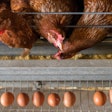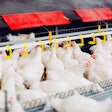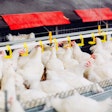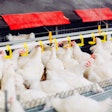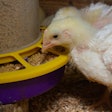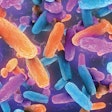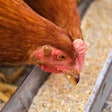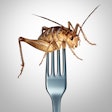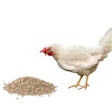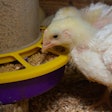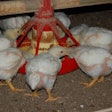
There follow summaries of a selection of papers and posters presented at poultry conferences this year. Broilers, layers, broiler breeders and turkeys are all represented, together with two investigations on the feeding of new or unusual feed ingredients for poultry.
Organic diets present problems for pullets
The growing demand in western countries for organic food has presented poultry nutritionists with a number of difficulties in formulating feeds that meet the requirements of both the birds and the increasingly strict regulations that govern permitted feed ingredients. To allow the identification of specific problems of organic diets to be explored and solutions found, permission was granted temporarily in the EU to permit synthetic amino acids to be included in organic feeds. The end of this so-called derogation is now in sight; all ingredients will have to be certified as organic from 2010.
One nutritional aspect concerning Scottish Agricultural College researchers is to meet the broiler's requirement for sulphur amino acids, particularly methionine, in a 100%-organic diet. Insufficiency of these nutrients may have adverse effects on health and welfare, as well as performance.
Dr Acamovic and his colleagues compared the performance of birds up to 16 weeks of age when fed either a conventional diet (C) or a basal organic diet (B), and the effects of supplementing the latter with a range of organic supplements including methionine, betaine, saponins or fructo-oligosaccharides. All diets were based on wheat and full-fat soybean meal, and all birds were allowed access to range outside from 11 weeks of age.
The only B diet that matched the C diet in terms of bodyweight and feed efficiency was the one containing supplemental methionine. All the other B diets gave numerically (and sometimes statistically significantly) much poorer results.
On a positive note, the authors remarked that all the birds remained healthy during the trial, and although feed efficiency was low, performance exceeded the standards for organic rearing.
Best practice for feeding layers
Dr Philippe Joly of ISA-Hendrix Genetics reviewed a great number of scientific papers for his review on layer feeding. He concentrated particularly on the effects of feed dilution on egg production, the effects of adding different types and levels of fat and finally, the effects of feed form (pellets versus mash; small versus large particles and fibre content).
From his review, Dr Joly made a number of recommendations. Among these is that prior to the onset of lay, pullets should be fed a diet lower in energy than the laying feed, in order to encourage intake as the birds come into lay. At this time, energy intake needs to be increased, for example, by increasing the fat content of the diet, in order to obtain eggs of marketable size. After the onset of lay, energy level should be reduced slightly. This can be achieved with a diet higher in cellulose. It will optimise energy efficiency and can help to prevent feather pecking and cannibalism. Feed form can greatly affect energy consumption: particles that are too small reduce feed intake.
In summary, Dr Joly concluded that the fullest expression of the hen's genetic potential for egg production will be achieved with the correct balance of feed presentation, fat content and fibre content.
Effects of drying temperatures of maize for broilers
Worldwide, maize continues to be the most commonly used cereal component in broiler diets. It is perceived to have a consistent nutritional value but there is evidence that its energy content can vary considerably. Researchers from Poland's August Cieszkowski Agricultural University and from Danisco have examined a so-far neglected factor, namely post-harvest treatment. They fed diets containing maize dried at different temperatures (80, 120 or 140°C), with and without a feed enzyme product (Avizyme 1502, 0.1%) to broilers. The maize was included at 488 and 602.5g/kg in the starter and grower diets, respectively. The starter was fed from days 1-14, and the grower on days 15-35.
Generally, the performance of the birds fed the maize dried at 140°C was inferior to the other groups, with significantly lower bodyweight gains and feed efficiencies for each period and overall (P<0.05). The enzyme product was effective in improving the bodyweights of the birds fed the maize dried at the highest temperature but performance still did not match the birds fed the maize dried at 80 or 120°C.
It is normal practice to dry maize if drying is required at 120°C although higher temperatures may be used if the harvested material is particularly wet and drying capacity is limited. The results of this experiment indicate that the feeding value of maize is significantly impaired if a higher-than-normal drying temperature is applied.
Feeding frequency for broiler breeders
J.M. Spradley and colleagues at the University of Georgia have carried out a number of studies into ways of restricting feed intake of breeders in order to optimise egg production. For example, they found that continuing skip-a-day feeding after photo-stimulation reduced egg production by 15 eggs per hen to 65 weeks.
The same group reported a trial in which pullets were reared used a skip-a-day programme from 2 to 21 weeks of age. They were then assigned to one of two treatments. The birds were assigned so that each pen group of 35 hens and 4 roosters had the same average weight. The two treatments were once daily feeding (at 06:30) or twice a day (at 06:30 and 15:00). Total feed intake was kept the same for both treatments. The birds fed twice daily produced significantly more eggs during the trial period (to 29 weeks of age). The coefficient of variation for bodyweight of these birds was also significantly lower, indicating that they were more uniform than the birds fed only once a day.
Practical challenges for feeding DDGS to turkeys
The dramatic growth in ethanol production from maize has led to large quantities of the by-product distillers dried grain with solubles (DDGS) suddenly coming onto the market as a feed ingredient in Asia, Europe, the Middle East and North Africa.
In a review of current feeding practices of commercial turkeys, Dr Klein-Hessling (International Poultry Consulting Services) stated that research confirms this new by-product has broadly the same nutritional characteristics as the DDGS from previous decades. There is considerable variability between different sources but material from the same ethanol plant is relatively consistent. Like maize, the limiting amino acids in DDGS are lysine, arginine and tryptophan. Processing procedures mostly affect the digestibility of lysine, threonine and cystine.
Extensive research has established a close correlation between the colour of DDGS and the digestibility of amino acids, with the light and yellow-coloured materials having quite consistent amino acid digestibility values.
A critical variable in DDGS is the amount of solubles (syrup) added into the wet mash before it is dried. The more syrup is added, the higher the contents of fat (and hence true metabolisable energy corrected for nitrogen retention, TMEn) and minerals, and the lower is the amino acid digestibility.
A recently published feeding trial indicates that 20% DDGS could be fed to young male turkeys without impairing performance. A hydrolysed high protein form of DDGS was successfully included in a starter feed at a level of 10%, and previous work with turkey hens suggested that around 20% DDGS could be included without a significant depression in performance.
Energy value of shea nut meal
Shea fat is in increasing demand worldwide. The shea tree (Vitellaria paradoxa) is widely grown in West Africa, and there is interest in the use of the by-product after fat extraction shea nut meal (SNM) for poultry diets. The fat is extracted from the nuts in one of two ways: the industrial method produces expeller meals, while a local method of water-extraction is also practised. Researchers from Harper Adams University College and Scottish Agricultural College assessed the chemical composition and metabolisable energy value of three samples of the SNM. The results, shown in Table 1, show a wide variation in the nutritive value of the materials, which will be problematical for feed formulation unless a chemical analysis is carried out on each sample beforehand. The authors suggest that it is the content of free fatty acids that is the most important quality measure of SNM.
Rapeseed biofuel residue for poultry
With the increasing use of oilseeds for biofuel production, more of the by-product meals are coming onto the feed ingredient market. In the European Union, 80% of biofuels currently derive from rapeseed, and a group of researchers from Scottish Agricultural College has analysed the resulting residue. At 124g/kg, the crude fat content of rapeseed biofuel residue (RBR) was 5 times higher than conventional solvent-extracted rapeseed meal (RSM), which usually around 26g/kg. As a result, gross energy was also considerably higher (22.5 versus 19.7MJ/kg, respectively). At 10.46MJ/kg, the metabolisable energy level of RBR was lower than legumes and cereals that usually form the basis of poultry diets in the EU. Apparent metabolisable energy was around the same as RSM. The poor metabolisability was attributed to the non-starch polysaccharide content of the residue.
Overall, the authors concluded that the RBR has a better nutritional value than conventional RSM and that supplementation with feed enzymes might be beneficial.
.jpg?auto=format%2Ccompress&fit=crop&h=167&q=70&w=250)



